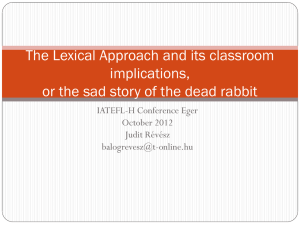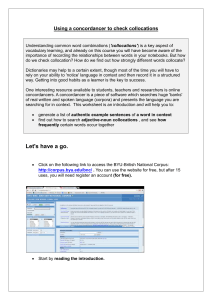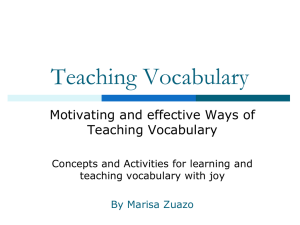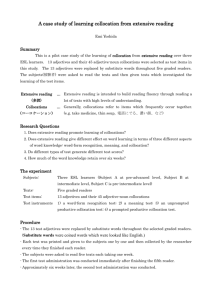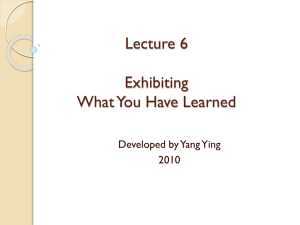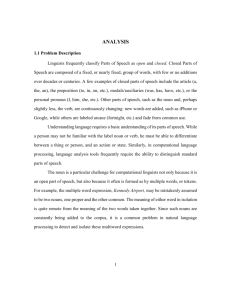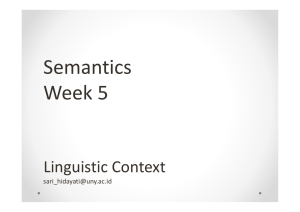Collocational Properties in Probabilistic Classifiers for Discourse
advertisement
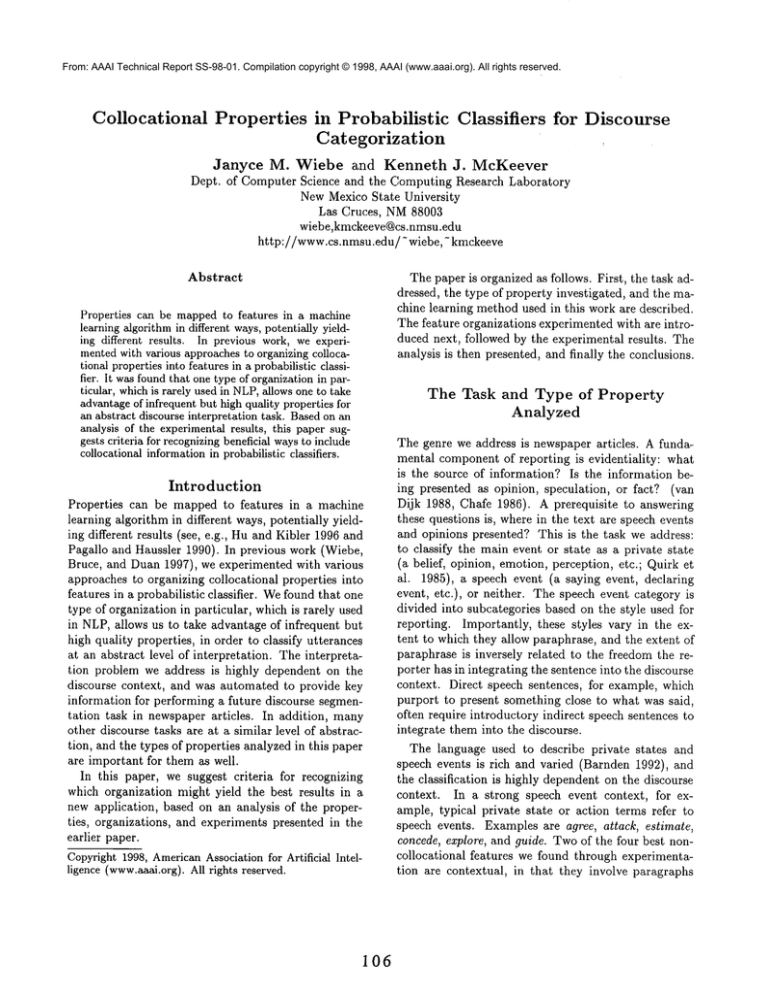
From: AAAI Technical Report SS-98-01. Compilation copyright © 1998, AAAI (www.aaai.org). All rights reserved.
Collocational
Properties in Probabilistic
Categorization
Classifiers
for Discourse
Janyce
M. Wiebe and Kenneth
J. McKeever
Dept. of Computer Science and the Computing Research Laboratory
NewMexico State University
Las Cruces, NM88003
wiebe,kmckeeve@cs.nmsu.edu
http://www.cs.nmsu.edu/" wiebe, - kmckeeve
Abstract
The paper is organized as follows. First, the task addressed, the type of property investigated, and the machine learning method used in this work are described.
The feature organizations experimented with are introduced next, followed by the experimental results. The
analysis is then presented, and finally the conclusions.
Properties can be mappedto features in a machine
learning algorithmin different ways,potentially yielding different results. In previous work, we experimentedwith various approachesto organizing collocational properties into features in a probabilistic classifier. It wasfoundthat one type of organizationin particular, whichis rarely used in NLP,allows one to take
advantageof infrequent but high quality properties for
an abstract discourse interpretation task. Basedon an
analysis of the experimental results, this paper suggests criteria for recognizingbeneficial waysto include
collocational informationin probabilistic classifiers.
The
Introduction
Properties can be mapped to features in a machine
learning algorithm in different ways, potentially yielding different results (see, e.g., Hu and Kibler 1996 and
Pagallo and Haussler 1990). In previous work (Wiebe,
Bruce, and Duan 1997), we experimented with various
approaches to organizing collocational properties into
features in a probabilistic classifier. Wefound that one
type of organization in particular, which is rarely used
in NLP, allows us to take advantage of infrequent but
high quality properties, in order to classify utterances
at an abstract level of interpretation. The interpretation problem we address is highly dependent on the
discourse context, and was automated to provide key
information for performing a future discourse segmentation task in newspaper articles. In addition, many
other discourse tasks are at a similar level of abstraction, and the types of properties analyzed in this paper
are important for them as well.
In this paper, we suggest criteria for recognizing
which organization might yield the best results in a
new application, based on an analysis of the properties, organizations, and experiments presented in the
earlier paper.
Copyright1998, AmericanAssociation for Artificial Intelligence (www.aaai.org).All rights reserved.
106
Task
and Type
Analyzed
of
Property
The genre we address is newspaper articles. A fundamental component of reporting is evidentiality:
what
is the source of information? Is the information being presented as opinion, speculation, or fact? (van
Dijk 1988, Chafe 1986). A prerequisite to answering
these questions is, where in the text are speech events
and opinions presented? This is the task we address:
to classify the main event or state as a private state
(a belief, opinion, emotion, perception, etc.; Quirk et
al. 1985), a speech event (a saying event, declaring
event, etc.), or neither. The speech event category is
divided into subcategories based on the style used for
reporting. Importantly, these styles vary in the extent to which they allow paraphrase, and the extent of
paraphrase is inversely related to the freedom the reporter has in integrating the sentence into the discourse
context. Direct speech sentences, for example, which
purport to present something close to what was said,
often require introductory indirect speech sentences to
integrate them into the discourse.
The language used to describe private states and
speech events is rich and varied (Barnden 1992), and
the classification is highly dependent on the discourse
context. In a strong speech event context, for example, typical private state or action terms refer to
speech events. Examples are agree, attack, estimate,
concede, explore, and guide. Twoof the four best noncollocational features we found through experimentation are contextual, in that they involve paragraphs
1(Wiebe, Bruce, and Duan 1997).
Automatic detection of collocational information has
been found to be key for discourse processing by other
researchers as well (e.g., Daganand Itai 1994, Hearst
1994, Kurohashi and Nagao 1994, Liddy, Paik, and
McKenna1995, and Beeferman, Berger, and Lafferty
1996). It is important to note that there are many
discourse categorizations in the literature that are as
abstract as the one addressed here. Some examples
are speech acts, rhetorical relations of various kinds
(Mann and Thompson1983, Hobbs 1979), Liddy, Paik,
and McKenna’s (1995) news schema components, and
Moser, Moore, and Glendening’s (1997) intentionalstructure and informational-structure
relations. The
findings in this paper are directly applicable for designing experiments to discover collocations of these
other categorizations. For recognizing such abstract
discourse categories, collocations can be conceived of
as words that occur in some relation with the class
(not other words). For example, "believe" as the main
verb and "angry" as the head of an adjectival complement are good collocation words for the private state
class. From this perspective, collocations can include
any kind of lexical indicators or "hints" of the abstract
class. And, using a method that allows for both collocational and non-collocational properties allows one to
investigate such clues in combination with others.
Machine
Learning
Method
Suppose there is a training sample where each tagged
sentence is represented by a vector (F1,..., Fn-1, S),
where the input features
are represented
by
(F1,...,Fn-1) and the targeted classification is represented by S. Our task is to induce a classifier that
will predict the value of S given an untagged sentence
represented by the input features. This prediction is
made with respect to a probability model.
Weperform model search through the space of decomposableprobability models (Whittaker 1990) to find
a modelthat provides a good characterization of the relationships amongthe targeted classification and properties in the data (Bruce 1995, Bruce and Wiebe1994).
The methodpermits the use of manyfeatures of different kinds, including n-gram properties as well as the
types of features typically included in MaximumEntropy models (Berger, A. Della Pietra, and V. Della
Pietra 1996) and Decision Trees (Breiman et al. 1984).
In addition, as in Decision Tree Induction, feature selection can be performed as part of the process of model
formulation.
I Oneis the percentage of the paragraphso far that is
composedof private states and speech events, and the other
is whether or not the sentence begins a new paragraph.
107
Manyresearchers have applied Decision Tree Induction to discourse tasks (e.g., Litman 1994, Siegel and
McKeown1994, Soderland and Lehnert 1994, and Di
Eugenio,Moore, and Paolucci 1997). As different algorithms perform better on different tasks, our method
provides a good alternative method for experimentation. The model search procedure can be performed
using the public domain program CoCo (Badsberg
1995). This platform allows one to experiment with
many parameters, such as the order of search and the
goodness-of-fit criterion used (Pedersen, Bruce, and
Wiebe 1997). Such experiments can give one additional insight into the relative importance of variables
and the interdependencies among them.
The choices described in the remainder of this paper
are equally relevant for decision trees, our method, or
any other method able to represent the types of features discussed.
Collocational
Probabilistic
Properties
Classifiers
in
To include collocational properties as input features in
a probabilistic classifier, there are three steps: defining
the collocation type (e.g., being the mainverb); identifying words that, whenthey satisfy those criteria, are
indicative of the classification being made(e.g., the set
of words such that, when they are used as main verbs,
they are good indicators of the class); and, finally, organizing the collocational words into features. Wiebe,
Bruce, and Duan (1997) define three collocation types:
occurrence anywhere in the sentence (collocation type
CO), occurrence within a windowof five words around
the main verb (collocation type W5), and occurrence
in particular syntactic patterns (collocation type SP).
Each collocation type is defined with multiple patterns.
For COand W5,each is for a different part of speech,
and for SP, they are regular expressions composed of
parts of speech and the root forms of words, corresponding to basic syntactic structures.
Our best results were obtained with the SP collocations. Such collocations can better pinpoint a particular state or event out of all those referred to in the
sentence, eliminating noise. Appropriate patterns can
be defined for the particular genre and task at hand.
The important properties of these collocations are that
they are high quality but infrequent (see the later section presenting the analysis). One would expect such
properties to be important for abstract discourse categorizations, because each category covers an extreme
numberof different realizations.
The COand W5collocations were defined for contrastive analysis: because they are less construined,
they are more frequent but of lower quality than the
SP collocations.
There are two ways to identify collocation words.
Let there be c classes, C1 to Co. Let there be p collocational patterns for a collocation type, P1 to Pp. In
the per-class method, words are selected that are correlated with class Ci when they appear in pattern Pj;
these are denoted as WordsCiPj. In the over-range
method, words are selected that, when they appear in
pattern Pj, are correlated with the classification variable across its entire range of values. These are denoted as WordsPj. For each identification
method,
we experimented with two different ways to organize
the collocational properties into features. The identification methods and organizations defined in Wiebe,
Bruce and Duan (1997) are presented in the following
subsections.
Per-Class
Collocations
Per-Class Method for Identifying
Collocations
The criterion used here and in Ng and Lee 1996 for
forming the collocation sets WordsCiPj is (we use
= 0.5): WordsCiPj = {w [P(C~[w in Pj) > k}.
Organization per-class-1
(PC1) There is one binary feature for each class Ci, whose value is 1 if any
memberof any of the sets WordsCiPj appears in the
sentence, 1 < j < p.
Organization per-class-2
(PC2) For each pattern
Pj, a feature is defined with c÷ 1 values as follows: For
1 < i < c, there is one value which corresponds to the
presence of a word in WordsCiPj. Each feature also
has a value for the absence of any of those words.
Over-Range
Collocations
Over-Range Method for Identifying
Collocations In this alternative, the criterion for identifying members of the collocation sets WordsPj is that
they be interdependent with the classification variable
(since independent words would not be useful).
implement this criterion, words are considered to be
binary variables (1 for their presence and 0 for their
absence), and the model of independence between each
word and the classification variable is assessed, using
a goodness-of-fit statistic. A goodness-of-fit statistic is
used to measure how closely the counts observed in a
sample correspond to those that would be expected if
the model being tested is the true population model.
In this work, the likelihood ratio statistic, G2 (Bishop,
Fienberg, and Holland 1975), is used. It can be formulated as (where N is the total numberof objects in the
training sample, i represents a distinct realization of
the data vector, i.e., a possible combinationof the values of the variables, fi is the sample relative frequency
of realization i, and Pi is the probability of realization
i defined by the model):
G2=-2N
×Eli
xlogPi
The greater the G~ value, the poorer the fit of the
model.
For the model of independence between two variables
X and Y, each i is a combination of one value of X,
z, and one value of Y, y, and
Pi=fz×
fy
where fz and fu are the sample relative frequencies of
z and y, respectively.
The members of the collocation sets WordsPj are
chosen to be words w such that, when w appears in
pattern Pj, the model of independence between the
classification variable and w has a poor fit, as measured
2.
by G
Organization over-range-1
(OR1) This organization is used in positional features such as in Gale,
Church, and Yarowsky (1992a) and Leacock, Towell,
and Voorhees (1993). One feature is defined per pattern Pj, with [ WordsPj[ +1 values, one value for each
word in WordsPj (i.e., each word selected for pattern
Pj using G2 as described above). Each feature also has
a value for the absence of any word in WordsPj.
Organization over-range-2 (O1%2) This organization is commonlyused in NLP. A binary feature is defined for each word in each set WordsPj, 1 < j <_ p.
Results
Table 1 presents the experimental results from
Wiebe, Bruce, and Duan (1997) covarying type of collocational property (the columns) and type of organization (the rows). All experiments included four
other properties that were independently established
as good indicators of the class. The model search
procedure was not permitted to drop any features,
to support comparative analyses. The total amount
of data consists of 2,544 main clauses from the Wall
Street Journal Treebank corpus (Marcus, Santorini,
and Marcinkiewicz 1993). The lower bound for the
problem--the frequency in the entire data set of the
most frequent class (Gale, Church, and Yarowsky
1992b)--is 52%.
10-fold cross-validation
was performed. For each
fold, the collocations
were determined and model
search was performed anew. All training, including
model selection, was performed on the training data,
and the results in table 1 are averages across folds.
108
OR-1
OR-2
PC-1
PC-2
Co-occurrence Patterns
Accuracy Precision Recall
0.6967
0.9815
0.6838
0.7164
0.9858
0.7063
0.5315
0.5364
0.9906
0.6500
0.6571 0.9886
Within-5 Patterns
Accuracy Precision
Recall
0.6020
0.6144
0.9799
0.7082
0.7147
0.9909
0.5568
0.9969
0.5550
0.6567
0.6604 0.9945
Syntactic Patterns
Accuracy Precision
Recall
0.7056
0.9976
0.7039
0.7114
0.7158 0.9937
0.7382
0.7431
0.9933
0.7468
0.7495 0.9965
Table 1: 10-fold Results Varying Collocation Type and Feature Organization
Frequency:
CO
W5
SP
> 50
15
18
3
41-50
12
16
0
31-40
17
26
1
21-30
62
53
3
11-20
106
135
15
Table 2: Frequency of Collocation Words Identified
Table 1 shows that no single organization is best
for all kinds of properties, and that the per-class organizations were required to take advantage of the SP
collocations.
with the Per-Class Method
CO
.890
W5 SP
.902 .174
Table 3: Percentage of Sentences with > 1 Collocation
WordIdentified Per-Class
Analysis
In this section, the properties, organizations, and results shown in table 1 are analyzed in order to gain
insight into the pattern of results and develop some
diagnostics for recognizing when the per-class organizations may be beneficial.
Weconsider a number of
factors, including conflicting class indicators, entropy,
conditional probability of class given feature, and event
space complexity.
Two types of information that will be relevant
throughout are frequency and co-occurrence. Table
2 illustrates the lower frequency of the SP collocation
words. Specifically, it shows the numberof occurrences
(in the appropriate pattern) of collocation words identified using the per-class methodin one training set. A
related statistic is howoften two collocation words appear in the same sentence. As they are defined, SP collocations are not likely to co-occur in a single sentence,
while the COand W5collocations often do. This is illustrated in table 3, which showsco-occurrence of collocation words identified using the per-class methodin
one training set.
Conflicting
1
6-10 3-5 2
115 299 401 925
116 234 231 467
18
52 52 132
and, on the other hand, the SP collocation type. In this
section, we examine this pattern.
The PC organizations appear to be vulnerable to
collocations that indicate conflicting classes, because
the collocation words are selected to be those highly
indicative of a particular class. Recall that the collocation sets used in the PC organizations are of the form
WordsCjPi. Two words indicate conflicting classes if
one is in a set WordsCjPi and the other is in a set
WordsCkPt, where j ¢ k.
Table 4 shows that the COand W5collocations often conflict, while the SP collocations rarely conflict.
Comparing the SP column of this table to the SP col-
PC1
PC2
CO
.570
.378
W5 SP
.628 .049
.312
.011
Table 4: Percentage of Sentences with Conflicting Collocation Words
Class Indicators
Notice that, in Table 1, performance with the OR1and
OR2organizations is relatively flat. In contrast, there
are large differences for the PC organizations between,
on the one hand, the COand the W5collocation types,
109
umnof table 3, we see that fewer than 1/3 of the few
existing co-occurrences lead to conflicts.
It appears that the PC organizations lead to higher
accuracy when there are fewer conflicting
words.
collocation
As can be seen in table 6, which shows average entropy, SP collocations have considerably lower entropy
than the others. Table 7 shows that, on average, the
Measures of Feature Quality
Weargue that, for the per-class organizations to
be beneficial, the individual collocation words must
strongly select a single majority class. Consider the
example in table 5, which was constructed for illustrative purposes. It showsthe conditional distributions of
two collocation words, wl and w2, identified per-class,
according to the same pattern, say p3 (e.g., both are
main-verb per-class collocations).
p(cllwl)=.O0
p(c41wl)=.64
p(cl[w2)=.02
p(c4[w2)=.58
p(c21wl)=.O0
p(c51wl)=.24
p(c21w2)=.22
p(c5[w2)=.15
I
CO
1.015
Table 6: Average Entropy of the Collocation
Identified for the OR2Experiments
t
CO W5 SP
t
0.619 0.652 0.797
Both would be included in the set WordsCc4Pp3,
since both indicate c4 as the most probable class. However, notice that the second most probable classes are
different: c5 for wl and c2 for w2. Information concerning the second most probable class is lost when
the words are included in the same set WordsCc4Ppa,
but the words are each associated with another class
between 20%-25%of the time. If the conditional probability of the most strongly associated class were higher
for both words, the frequency of the secondary association would be reduced, resulting in fewer erroneous
classifications.
Weuse two measures to assess how strongly collocation words select single majority classes: entropy and
conditional probability of class given feature.
Note that the per-class methodof identification adlnits a large numberof low-frequency words (see table
2). The quality of low frequency collocations is difficult to directly measure. For example, entropy tends
to be an unreliable measure for features that occur infrequently (Clark and Boswell 1991). Tables 6 and
show statistics calculated for the more frequent words
selected in commonunder each of the CO, W5and SP
constraints in one training fold. The 17 selected words
all occur at least 10 times under each constraint in the
training set used. Since we measured an identical set
of words under the three collocation constraints, we
believe the results strongly reflect the quality of those
constraints.
The entropy of the conditional distribution of the
classification variable C given value f of feature F is:
x log(p(c
Words
SP collocation words are more strongly indicative of a
single class.
p(c31wl)=.ll]
p(c6twl ) .01
p(c3[w2)=.03]
p(c6[w2)
.00
Table 5: Example Conditional Distributions
H = - E p(c IF = f)
ca{C1
,...,co}
W5
SP
0.933 0.565
Table 7: Average Conditional Probability of Most
Probable Class Given Collocation WordIdentified for
the OR2 Experiments
A Benefit of Per-Class Organizations:
more information
without
added
complexity
As shown above in tabels 2, 3, 4, 6, and 7, collocation words of the more constrained SP collocation
type are lower in frequency and of higher quality than
the COand W5collocations. Because the SP collocations are low frequency, using them requires identifying
and including a larger number of collocation words. In
the more traditional over-range organizations, increasing the number of words increases the complexity of
the event space, in O1%1by increasing the number of
feature values and in OR2by increasing the number
of features. These increases in complexity can cause
poor accuracy and considerably longer computation
time (Bruce, Wiebe, and Pedersen 1996). The perclass organizations allow us to increase the numberof
collocation words without increasing complexity.
To assess the influence of the per-class organizations
when the numberof collocation words is not increased,
we performed the following exercise. Wetook the collocation words that were included in the original O1%1experiment and organized them as PC2 (the more closely
related PC organization), and similarly for O1%2and
PC1.
Whenthe features were so transformed, the accuracy, precision and recall of classifying sentences by
main clause type was virtually unchanged, as shownin
] F =
110
co
W5
Acc Pre Recall
.610 .611 .992
.602 .614
.980
.715 .716 .992
.991
.708 .715
Acc Pre Recall
OR1 grouped as PC2 .699 .699 1.00
Original .684 .697
.98
OR2 grouped as PC1 .722 .722
.991
Original
.706 .716
.986
Table 8: Performance with ORCollocation
SP
Acc Pre Recall
.707 .707 1.00
.704 .706 .998
.720 .720 .991
.711 .716 .994
Words Mapped to PC Collocation
Features
References
table 8. The results suggest that simply applying the
PCorganizations to existing properties will not result
in significant improvement. The improved results for
the SP collocations under the PC organizations appear
to be due largely to the following: A large number of
good-quality SP collocations exist, and the PC organizations allow them to be included without adding
complexity to the event space.
Badsberg, J. 1995. An Environment for Graphical
Models. Ph.D. diss., Aalborg University.
Barnden, J.A. 1992. Belief in Metaphor: Taking Commonsense Psychology Seriously. Computational Intelligence 8 (3): 520-552.
Beeferman, D.; Berger, A.; and Lafferty, J. 1996. Text
Segmentation Using Exponential Models. Proceedings
of the Conference on Empirical Methods in Discourse
(EMNLP-2), 35-46. Association for Computational
Linguistics.
Conclusions
In probabilistic machine learning approaches to recognizing abstract categories, such as private states,
speech events, speech acts, and rhetorical relations, it
is desirable to be able to include low frequency, highquality properties. They are particularly likely to arise
for such abstract discourse categories, because an extreme numberof different realizations fall under a single category.
In NLP, people have taken various approaches to
handling low-frequency properties, such as considering
only positive evidence (Hearst 1992) or only the single
best piece of evidence (Yarowsky 1993). Our approach
to taking advantage of low frequency, high quality evidence is particularly relevant for NLPsystems incorporating collocational properties: the properties must be
identified and organized in some way, so these choices
must be made in any event. In this paper, we suggest criteria for recognizing whena class-specific organization of properties into features might be beneficial,
based on analyses of experimental results.
Berger, A.; Della Pietra, A.; and Della Pietra, V. 1996.
A MaximumEntropy Approach to Natural Language
Processing. Computational Linguistics 22 (1): 39-72.
Bishop, Y. M.; Fienberg, S.; and Holland, P. 1975.
Discrete Multivariate Analysis: Theory and Practice.
Cambridge: The MIT Press.
Breiman, L.; Friedman, J.; Olshen, R.; and Stone, C.
1984. Classification and Regression Trees. Monterey,
CA: Wadsworth & Brooks/Cole Advanced Books &
Software.
Bruce, R. (1995). A Statistical Methodfor Word-Sense
Disambiguation. PhD diss., Dept. of Computer Science, NewMexico State University, 1995.
Bruce, R.; Wiebe, J., and Pedersen, T. 1996. Proceedings of the Conference on Empirical Methods in
Discourse (EMNLP-1), 101-112. Association for Computational Linguistics.
Acknowledgements
This research was supported in part by the Office of
Naval Research under grant number N00014-95-1-0776.
We thank Julie Maples for her work developing the
annotation instructions and manually annotating the
data, Rebecca Bruce for her insightful suggestions and
comments, and Lei Duan for his work implementing
the original experiments.
Bruce, R. and Wiebe, J. 1994. Word-Sense Disambiguation Using Decomposable Models. Proceedings of
the Thirty Second Annual Meeting of the Association
for Computational Linguistics (ACL-94), pp 139-146.
Association for Computational Linguistics.
111
cial Intelligence.
Chafe, W. 1986. Evidentiality in English Conversation
and AcademicWriting. In: Chafe, W. and Nichols, J.,
Eds., Evidentiality: The Linguistic Coding of Epistemology. Ablex, Norwood, N J: 261-272.
Clark P. and Boswell, R. 1991. Rule Induction With
CN2: Some Recent Improvements. In Y. Kodratoff
(ed.), Machine Learning- EWSL-91(Berlin: SpringerVerlag) : 151-163.
Dagan, I. and Itai, A. 1994. Automatic Processing of
Large Corpora for the Resolution of Anaphora Resolution. Proceedings of the Fifteenth International Conference on Computational Linguistics (COLING-94),
330-332.
Di Eugenio, B.; Moore, J.; and Paolucci, M. 1997.
Learning Features that Predict Cue Usage. Proceedings of the Thirty Fifth Annual Meeting of the Assoc.
for Computational Linguistics (ACL-97), 80-87. Association for Computational Linguistics.
van Dijk, T.A. 1988. News as Discourse.
Erlbaum.
Lawrence
Gale, W.; Church, K.; and Yarowsky, D. 1992a. A
Method for Disambiguating Word Senses in a Large
Corpus. AT&TBell Laboratories Statistical
Research
Report No. 104.
Gale, W.; Church, K.; and Yarowsky, D. 1992b. Estimating Upper and Lower Bounds on the Performance
of Word-Sense Disambiguation Programs. Proceedings
of the Thirtieth Annual Meeting of the Assoc. for
Computational Linguistics (ACL-92), 249-264. Association for Computational Linguistics.
Hearst, M. 1994. Multi-Paragraph Segmentation of
Expository Text. Proceedings of the Thirty Second
Annual Meeting of the Assoc. for Computational Linguistics (ACL-94), 9-16. Association for Computational Linguistics.
Hearst, M. (1992). Automatic acquisition ofhyponyms
from large text corpora. Proceedings of the Fourteenth
International Conference on Computational Linguistics (COLING-92).
Hu, Y.J. and Kibler, D. 1996. Generation of Attributes
for Learning Algorithms. Proceedings of the Fourteenth National Conference on Artificial Intelligence
(AAAI-96), 806-811. American Association for Artifi-
Hobbs, J. 1979. Coherence and Coreference. Cognitive
Science 3: 67-90.
Kurohashi, S. and Nagao, M. 1994. Automatic Detection of Discourse Structure by Checking Surface Information in Sentences. Proceedings of the Fifteenth International Conference on Computational Linguistics
(COLING-94), 1123-1127.
Leacock,C.; Towell, G.; and Voorhees, E. 1993.
Corpus-Based Statistical
Sense Resolution. Proceedings of the 1993 Speech and Natural Language ARPA
Workshop.
Liddy, E.; Paik, W.; and McKenna, M. 1995. Development and Implementation of a Discourse Model for
Newspaper Texts. Working Notes of the AAAISpring
Symposium, Empirical Methods in Discourse Interpretation and Generation, 81-84. American Association
for Artificial Intelligence.
Litman, D. 1994. Classifying Cue Phrases in Text and
Speech Using Machine Learning. Proceedings of the
Twelfth National Conference on Artificial Intelligence
(AAAI-94). American Association for Artificial Intelligence.
Mann, W. C. and Thompson, S. S. 1983. Relational Propositions in Discourse. Technical Report No.
ISI/RR-83-115, University of Southern California Information Sciences Institute).
Marcus, M.; Santorini, B.; and Marcinkiewicz, M.
1993. Building a Large Annotated Corpus of English:
The Penn Treebank. Computational Linguistics 19 (2):
313-330.
Moser, M.; Moore, J.; and Glendening, E. 1997. Instructions for Coding Explanations: Identifying Segments, Relations, and Minimal Units. Technical Report 96-17, Department of Computer Science, University of Pittsburgh.
Ng, H., and Lee, H. 1996. Integrating
Multiple
Knowledge Sources to Disambiguate Word Senses: An
Exemplar-Based Approach. Proceedings of the Thirty
Fourth Annual Meeting of the Assoc. for Computational Linguistics (ACL-96), 40-47. Association for
Computational Linguistics.
Pagallo, G. and Haussler,
112
D. 1990. Boolean Feature
Discovery in Empirical Learning. Machine Learning,
5: 71-99.
Pedersen, T.; Bruce, R.; and Wiebe, J. 1997. Sequential Model Selection for WordSense Disambiguation.
Proceedings of the 1997 Conference on Applied Natural Language Processing (ANLP-97), 388-395. Association for Computational Linguistics.
Quirk, R.; Greenbaum,S.; Leech, G.; and Svartvik, J.
1985. A Comprehensive Grammarof the English Language. (New York: Longman).
Siegel, E. and McKeown,K. 1994. Emergent Linguistic
Rules from Inducing Decision Trees: Disambiguating
Discourse Clue Words. Proceedings of the Twelfth National Conference on Artificial Intelligence (AAAI-94).
AmericanAssociation for Artificial Intelligence.
Soderland, S. and Lehnert, W. 1994. Corpus-Driven
Knowledge Acquisition for Discourse Analysis. Proceedings of the Twelfth National Conference on Artificial Intelligence (AAAI-94). American Association for
Artificial Intelligence.
Whittaker, J. 1990. Graphical Models In Applied Multivariate Statistics.
NewYork, NY: John Wiley
SOILS.
Wiebe, J.; Bruce, R.; and Duan, L. 1997. Probabilistic Event Categorization. Proceedings of the Conference on Recent Advances in Natural Language Processing (RANLP-97), 163-170. European Commission,
DG XIII.
Yarowsky, D. 1993. One Sense Per Collocation. Proceedings of the 1993 Speech and Natural Language
ARPA Workshop.
113

